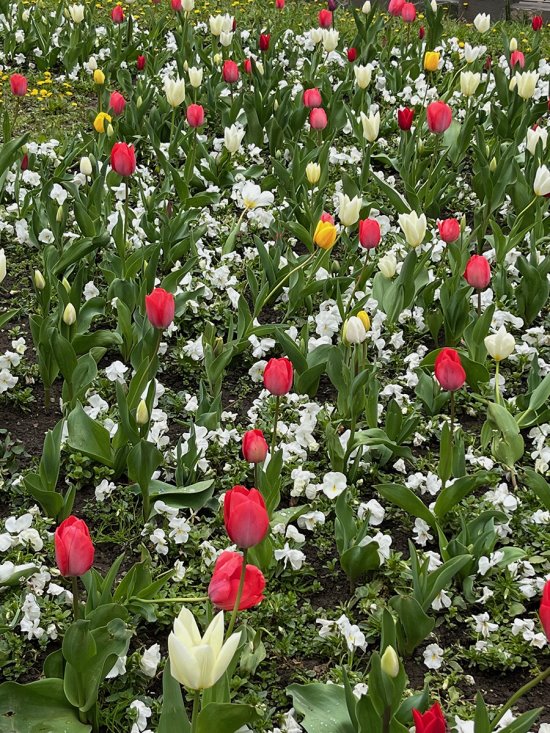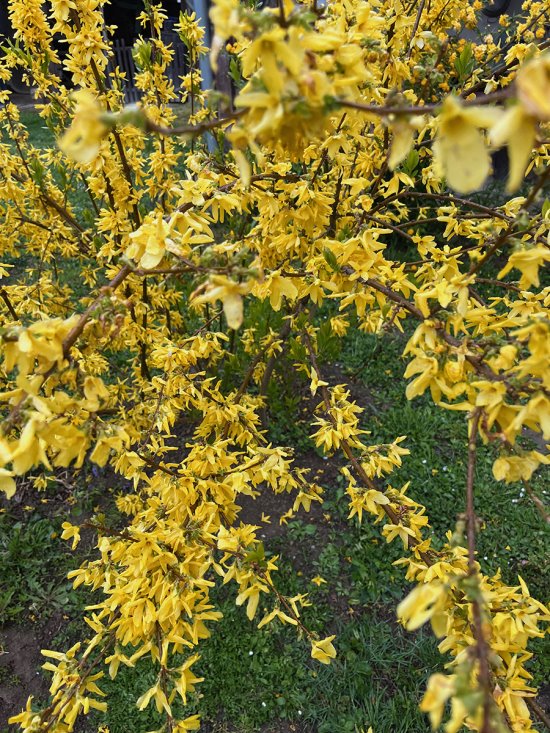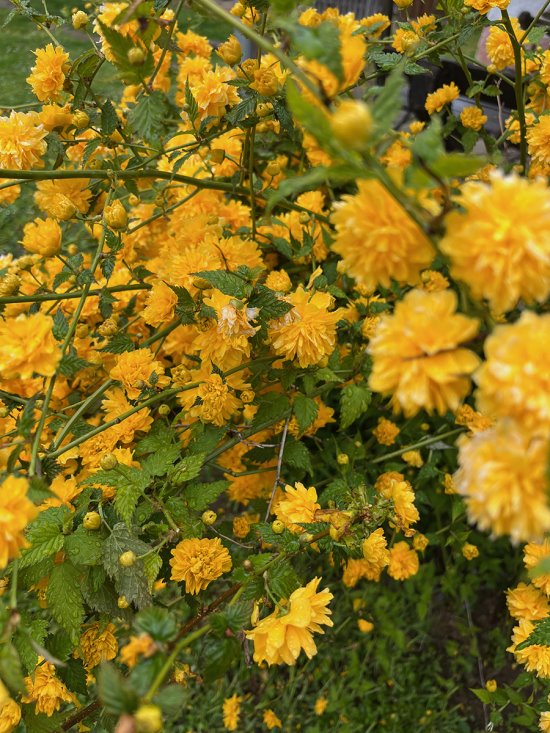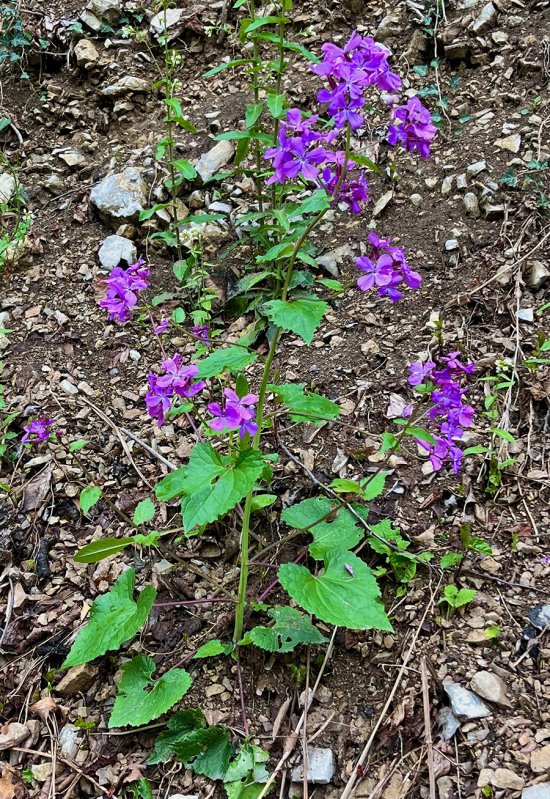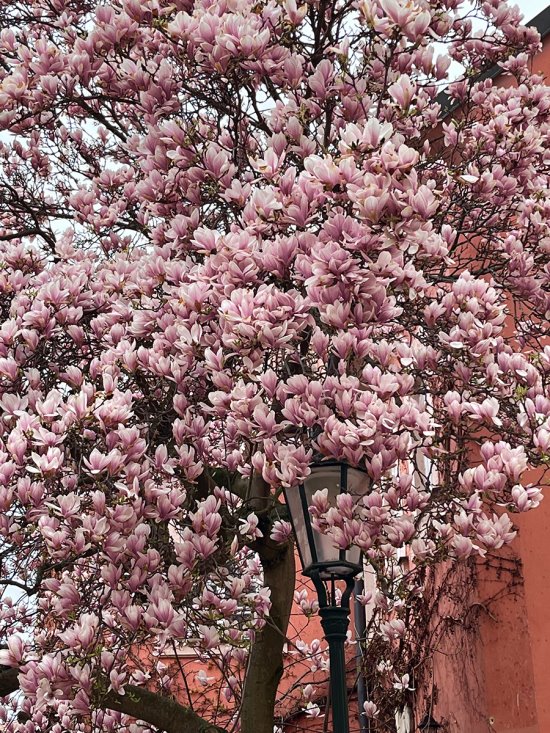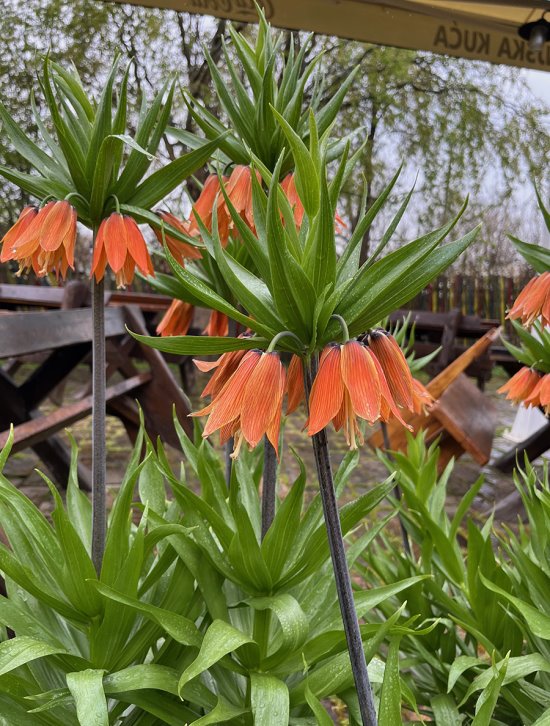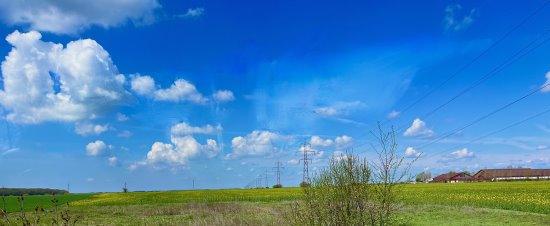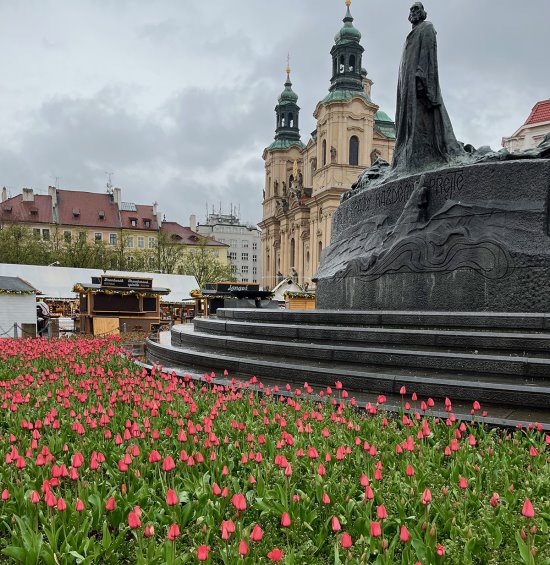 |
|
|
Red tulips in Prague, Czech Republic Photo Cynthia Brian
|
|
|
|
|
|
"Every spring is the only spring, a perpetual astonishment." ~ Ellis Peters
 My legs feel like jelly and my back is breaking. And the pain is not from gardening. It is from walking an average of 10 miles per day on cobblestone streets, up steep hills, down into the woods of national parks, and climbing medieval stairs to fortresses and castles throughout my springtime journey to the former Eastern Bloc countries of Hungary, Romania, Bulgaria, the Czech Republic, as well as Croatia and Serbia. Besides learning more about the history, culture, customs, people, and food, I was on a quest to identify the botanical specimens that we have in common.
My legs feel like jelly and my back is breaking. And the pain is not from gardening. It is from walking an average of 10 miles per day on cobblestone streets, up steep hills, down into the woods of national parks, and climbing medieval stairs to fortresses and castles throughout my springtime journey to the former Eastern Bloc countries of Hungary, Romania, Bulgaria, the Czech Republic, as well as Croatia and Serbia. Besides learning more about the history, culture, customs, people, and food, I was on a quest to identify the botanical specimens that we have in common.
 The original weather reports indicated mild temperatures, but a cold front suddenly appeared broadcasting freezing winds, rain, snowfall, and overcast gray days. Locals blamed the meteorologic conditions on climate change and global warming. Yet Mother Nature earnestly wanted to birth spring in a magical awakening from its winter slumber. The rich soil of these European countries provides a foundation for a variety of plants and trees, many of which are familiar to Californians.
The original weather reports indicated mild temperatures, but a cold front suddenly appeared broadcasting freezing winds, rain, snowfall, and overcast gray days. Locals blamed the meteorologic conditions on climate change and global warming. Yet Mother Nature earnestly wanted to birth spring in a magical awakening from its winter slumber. The rich soil of these European countries provides a foundation for a variety of plants and trees, many of which are familiar to Californians.
 Each country has a special association with a specific flower. During the Ottoman conquest, tulips were brought to these countries and tulips were blooming profusely in every land. Hungary claims the tulip as its national flower. Home to diverse wildflowers, including the Pasque flower, a harbinger of spring, Croatia calls the Dalmatian iris its own. The national symbol of Serbia is the plum tree, which was in full bloom throughout the country. Their national drink, Sljivovica, is made from plums. In Romania a wild climbing rose called Rosa Canina is utilized for both health and drinking and the purple Carpathian crocus is the first sign of spring. Bulgaria is the world's leading producer of rose oil used in perfumes and cosmetic products. The roses were not yet in bloom, but the bushes were filled with buds. I was compelled to purchase rose oil which is supposedly excellent for skin revitalization. The Czech Republic is home to a variety of spring- blooming flowers including crocus, tulips, and roses, and is known for its spectacular display of cherry blossom trees which create a stunning pink canopy over the cities and countryside. Blooming tulip magnolia trees were in glorious abundance, adding beauty to the already spectacular architecture.
Each country has a special association with a specific flower. During the Ottoman conquest, tulips were brought to these countries and tulips were blooming profusely in every land. Hungary claims the tulip as its national flower. Home to diverse wildflowers, including the Pasque flower, a harbinger of spring, Croatia calls the Dalmatian iris its own. The national symbol of Serbia is the plum tree, which was in full bloom throughout the country. Their national drink, Sljivovica, is made from plums. In Romania a wild climbing rose called Rosa Canina is utilized for both health and drinking and the purple Carpathian crocus is the first sign of spring. Bulgaria is the world's leading producer of rose oil used in perfumes and cosmetic products. The roses were not yet in bloom, but the bushes were filled with buds. I was compelled to purchase rose oil which is supposedly excellent for skin revitalization. The Czech Republic is home to a variety of spring- blooming flowers including crocus, tulips, and roses, and is known for its spectacular display of cherry blossom trees which create a stunning pink canopy over the cities and countryside. Blooming tulip magnolia trees were in glorious abundance, adding beauty to the already spectacular architecture.
 Bright yellow forsythia, called golden bells, was flowering throughout the region, along roads, in parks, and in forests. Forsythia is stoloniferous, which means when a branch meets the soil it takes root to start another bush. Part of the Brassicaceae mustard and cabbage family, rapeseed/canola farms were ubiquitous as a prosperous and financially lucrative crop. The rapeseed oil is used for diesel fuel and other industrial processes and the edible variety produces canola oil. Many people have allergies to the flowers and don't welcome the blanket of yellow blooms. Living walls of exotic plants, many of which we use as houseplants, were featured in several hotels and restaurants in Hungary, Bulgaria, and the Czech Republic. Apple, pear, and plum trees were in full blush throughout my sojourn, perfuming the chilly air.
Bright yellow forsythia, called golden bells, was flowering throughout the region, along roads, in parks, and in forests. Forsythia is stoloniferous, which means when a branch meets the soil it takes root to start another bush. Part of the Brassicaceae mustard and cabbage family, rapeseed/canola farms were ubiquitous as a prosperous and financially lucrative crop. The rapeseed oil is used for diesel fuel and other industrial processes and the edible variety produces canola oil. Many people have allergies to the flowers and don't welcome the blanket of yellow blooms. Living walls of exotic plants, many of which we use as houseplants, were featured in several hotels and restaurants in Hungary, Bulgaria, and the Czech Republic. Apple, pear, and plum trees were in full blush throughout my sojourn, perfuming the chilly air.
 I was surprised to see "lawns" consisting of dandelions, which were very attractive with their edible greens. Pansies in a variety of colors and patterns dotted the landscapes. There were specimens for which I was unfamiliar and intrigued including the butter yellow puff balls of the Kerria Japanese rose in Croatia, the Lunaria dotting the hillsides in the Djerdap National Park in Serbia, and the bright orange Crown Imperial perennial in Croatia.
I was surprised to see "lawns" consisting of dandelions, which were very attractive with their edible greens. Pansies in a variety of colors and patterns dotted the landscapes. There were specimens for which I was unfamiliar and intrigued including the butter yellow puff balls of the Kerria Japanese rose in Croatia, the Lunaria dotting the hillsides in the Djerdap National Park in Serbia, and the bright orange Crown Imperial perennial in Croatia.
 The Czech Republic enjoyed the most dramatic displays of horticultural bliss. The parks and squares were filled with blossoming European crabapples, tulip magnolias, and colorful tulips, as well as curated window boxes of colorful hyacinths, primroses, forget-me-nots, and other flowering bulbs.
The Czech Republic enjoyed the most dramatic displays of horticultural bliss. The parks and squares were filled with blossoming European crabapples, tulip magnolias, and colorful tulips, as well as curated window boxes of colorful hyacinths, primroses, forget-me-nots, and other flowering bulbs.
 My spring sojourn through Hungary, Croatia, Serbia, Romania, Bulgaria, and the Czech Republic has been a time of great beauty, wonder, and education. From delicate wildflowers to bold and bright flowering trees, these countries offered a stunning array of blooms, despite the wintery weather.
My spring sojourn through Hungary, Croatia, Serbia, Romania, Bulgaria, and the Czech Republic has been a time of great beauty, wonder, and education. From delicate wildflowers to bold and bright flowering trees, these countries offered a stunning array of blooms, despite the wintery weather.
 It is with appreciation that I return to my gorgeous garden in full bloom albeit overgrown with weeds. May is a busy time in the garden, but with a little effort, we can keep our plants healthy and thriving. Follow these tips for gardening chores, and you'll be well on your way to a beautiful landscape. With all the garden work ahead of me, I anticipate jelly legs and an aching back! Spring is a perpetual astonishment and worth the pain.
It is with appreciation that I return to my gorgeous garden in full bloom albeit overgrown with weeds. May is a busy time in the garden, but with a little effort, we can keep our plants healthy and thriving. Follow these tips for gardening chores, and you'll be well on your way to a beautiful landscape. With all the garden work ahead of me, I anticipate jelly legs and an aching back! Spring is a perpetual astonishment and worth the pain.


 Cynthia Brian's Goddess Gardener May Gardening Guide
Cynthia Brian's Goddess Gardener May Gardening Guide

 As the temperatures rise, our plants need more care and attention, so let's get to work.
As the temperatures rise, our plants need more care and attention, so let's get to work.
 WATER early in the morning as the weather warms to prevent evaporation.
WATER early in the morning as the weather warms to prevent evaporation.
 WEED constantly before weeds take over the garden. Remove the entire root system of weeds before sowing the seeds you want to grow.
WEED constantly before weeds take over the garden. Remove the entire root system of weeds before sowing the seeds you want to grow.
 PLANT warm-season vegetables including tomatoes, peppers, cucumbers, eggplant, zucchini, and whatever edibles your family enjoys eating.
PLANT warm-season vegetables including tomatoes, peppers, cucumbers, eggplant, zucchini, and whatever edibles your family enjoys eating.
 FERTILIZE your actively growing plants with a balanced fertilizer and follow the instructions carefully. Over-fertilizing can damage your plants, so don't be tempted to add more than recommended.
FERTILIZE your actively growing plants with a balanced fertilizer and follow the instructions carefully. Over-fertilizing can damage your plants, so don't be tempted to add more than recommended.
 IMPROVE the biodiversity of your soil ecosystem through mulching and composting. Spring and fall are the ideal times to increase organic matter and humus content. Adding compost to your garden reduces the need for chemical fertilizers, and allows the soil to hold water well which means less watering.
IMPROVE the biodiversity of your soil ecosystem through mulching and composting. Spring and fall are the ideal times to increase organic matter and humus content. Adding compost to your garden reduces the need for chemical fertilizers, and allows the soil to hold water well which means less watering.
 PICK up the last of the spent camellia blossoms from your garden to protect your plant for next season.
PICK up the last of the spent camellia blossoms from your garden to protect your plant for next season.
 SWEEP debris from driveways, walkways, steps, and porches to freshen up for spring.
SWEEP debris from driveways, walkways, steps, and porches to freshen up for spring.
 BRIGHTEN your curb appeal with colorful annuals and perennials including petunias, zinnias, cleome, salvia, dahlias, snapdragons, impatiens, and bachelor buttons.
BRIGHTEN your curb appeal with colorful annuals and perennials including petunias, zinnias, cleome, salvia, dahlias, snapdragons, impatiens, and bachelor buttons.
 PREVENT pests. Keep an eye out for aphids, whiteflies, and other common garden pests. You can use organic pest control methods like neem oil or insecticidal soap to keep them under control.
PREVENT pests. Keep an eye out for aphids, whiteflies, and other common garden pests. You can use organic pest control methods like neem oil or insecticidal soap to keep them under control.
 EMPTY standing water from pots, tires, neglected ponds, pools, or any place where mosquito larvae will breed. With all the rain we've had this year, mosquitoes could spread the West Nile virus and other diseases.
EMPTY standing water from pots, tires, neglected ponds, pools, or any place where mosquito larvae will breed. With all the rain we've had this year, mosquitoes could spread the West Nile virus and other diseases.
 CLEAR debris from your home and garden perimeter. Dried limbs, leaves, and weeds need to be removed. Fire season is upon us.
CLEAR debris from your home and garden perimeter. Dried limbs, leaves, and weeds need to be removed. Fire season is upon us.
 VISIT the Be the Star You Are!r booth at the Moraga Faire on Saturday, April 29 between 11 a.m. to 4 p.m. to pick up a bag of complimentary spring potpourri and have your kids plant seeds in our craft area. Bring your gardening questions and I'll be there to answer them. www.BetheStarYouAre.org/events
VISIT the Be the Star You Are!r booth at the Moraga Faire on Saturday, April 29 between 11 a.m. to 4 p.m. to pick up a bag of complimentary spring potpourri and have your kids plant seeds in our craft area. Bring your gardening questions and I'll be there to answer them. www.BetheStarYouAre.org/events
 DONATE your shoes: May 1-June 30: The Be the Star You Are!r charity Shoe Drive continues at these sponsored locations:
DONATE your shoes: May 1-June 30: The Be the Star You Are!r charity Shoe Drive continues at these sponsored locations:
 Mark Hoogs, State Farm Insurance, 629 Moraga Road, Moraga, 925-254-3344, www.TeamHoogs.com
Mark Hoogs, State Farm Insurance, 629 Moraga Road, Moraga, 925-254-3344, www.TeamHoogs.com
 5 A Rent-A-Space, 455 Moraga Rd. #F, Moraga, 925-631-7000, https://5aspace.com/
5 A Rent-A-Space, 455 Moraga Rd. #F, Moraga, 925-631-7000, https://5aspace.com/
 For more information, visit https://www.bethestaryouare.org/shoedrive
For more information, visit https://www.bethestaryouare.org/shoedrive
|

